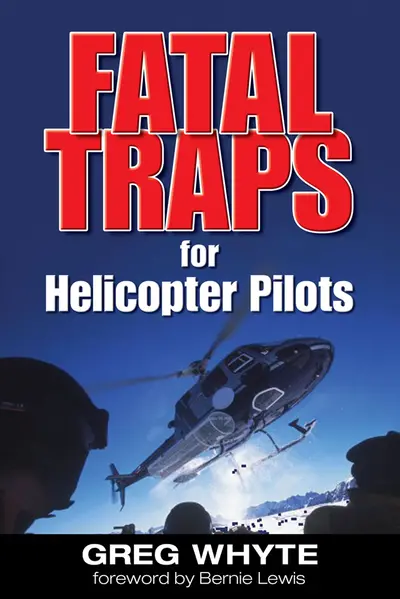My Account Details

ISBN10: 0071488308 | ISBN13: 9780071488303

Step 1 . Download Adobe Digital Editions to your PC or Mac desktop/laptop.
Step 2. Register and authorize your Adobe ID (optional). To access your eBook on multiple devices, first create an Adobe ID at account.adobe.com. Then, open Adobe Digital Editions, go to the Help menu, and select "Authorize Computer" to link your Adobe ID.
Step 3. Open Your eBook. Use Adobe Digital Editions to open the file. If the eBook doesn’t open, contact customer service for assistance.
Publisher's Note: Products purchased from Third Party sellers are not guaranteed by the publisher for quality, authenticity, or access to any online entitlements included with the product. Acquire the Life-Saving Skills Needed to Eliminate or Reduce Most Helicopter Accidents A vital resource for pilots, helicopter enthusiasts, and aircraft maintenance technicians, Fatal Traps for Helicopter Pilots analyzes all aspects of helicopter accidents, including flight basics, engineering, meteorology, flight training, and human factors. This life-saving guide shows how proper preparation can help prevent accidents by addressing causes such as aerodynamic problems, mechanical failures, poor loading, mid-air collisions, and more. Filled with case studies and first-hand accounts of accidents, the book organizes accident types by primary causes, presenting proven methods for eliminating or reducing the possibility of each type. Greg Whyte, an ex commercial helicopter pilot and professional aviation writer, draws on his own flying experiences and those of other flight veterans to provide a wealth of practical information and safety tips that are essential for everyone who flies, maintains or crews in helicopters. Filled with over 100 helpful illustrations, Fatal Traps for Helicopter Pilots enables readers to: Identify and address the common causes of helicopter accidents Explore in-depth examples of accident scenarios Examine the technical details of accident causes Review case studies and first-hand accounts of accidents Learn from the plain-English notes on avoidance and recovery Inside This Aviation Accident-Prevention Guide • Basic Flight Principles • Vortex Ring State • Recirculation • Ground Resonance • Retreating Blade Stall • Dynamic Rollover • Overpitching • Main Rotor Strikes • Mid-Air Collisions • Mast Bumping • Engine Failures • Tail Rotor Failures • Mechanical Failures • Fuel • Fire • Ditching • Loading Issues • Winching • Weather • Crew and Pre-flight Hazards • Human Factors • Training Mishaps
AcknowledgmentsForewordIntroductionChapter 1. Basic Flight PrinciplesChapter 2. Vortex Ring StateChapter 3. RecirculationChapter 4. Ground ResonanceChapter 5. Retreating Blade StallChapter 6. Dynamic RolloverChapter 7. OverpitchingChapter 8. Main Rotor StrikesChapter 9. Mid-Air CollisionsChapter 10.Mast BumpingChapter 11.Engine FailuresChapter 12. Tail Rotor FailuresChapter 13.Mechanical FailuresChapter 14.FuelChapter 15.FireChapter 16.DitchingChapter 17.Loading IssuesChapter 18.WinchingChapter 19.WeatherChapter 20.Crew and Pre-flight HazardsChapter 21.Human FactorsChapter 22.Training MishapsFurther ReadingIndex
IntroductionChapter 1. Basic Flight PrinciplesChapter 2. Vortex Ring StateChapter 3. RecirculationChapter 4. Ground ResonanceChapter 5. Retreating Blade StallChapter 6. Dynamic RolloverChapter 7. OverpitchingChapter 8. Main Rotor StrikesChapter 9. Mid-Air CollisionsChapter 10.Mast BumpingChapter 11.Engine FailuresChapter 12. Tail Rotor FailuresChapter 13.Mechanical FailuresChapter 14.FuelChapter 15.FireChapter 16.DitchingChapter 17.Loading IssuesChapter 18.WinchingChapter 19.WeatherChapter 20.Crew and Pre-flight HazardsChapter 21.Human FactorsChapter 22.Training MishapsFurther ReadingIndex
Chapter 2. Vortex Ring StateChapter 3. RecirculationChapter 4. Ground ResonanceChapter 5. Retreating Blade StallChapter 6. Dynamic RolloverChapter 7. OverpitchingChapter 8. Main Rotor StrikesChapter 9. Mid-Air CollisionsChapter 10.Mast BumpingChapter 11.Engine FailuresChapter 12. Tail Rotor FailuresChapter 13.Mechanical FailuresChapter 14.FuelChapter 15.FireChapter 16.DitchingChapter 17.Loading IssuesChapter 18.WinchingChapter 19.WeatherChapter 20.Crew and Pre-flight HazardsChapter 21.Human FactorsChapter 22.Training MishapsFurther ReadingIndex
Chapter 4. Ground ResonanceChapter 5. Retreating Blade StallChapter 6. Dynamic RolloverChapter 7. OverpitchingChapter 8. Main Rotor StrikesChapter 9. Mid-Air CollisionsChapter 10.Mast BumpingChapter 11.Engine FailuresChapter 12. Tail Rotor FailuresChapter 13.Mechanical FailuresChapter 14.FuelChapter 15.FireChapter 16.DitchingChapter 17.Loading IssuesChapter 18.WinchingChapter 19.WeatherChapter 20.Crew and Pre-flight HazardsChapter 21.Human FactorsChapter 22.Training MishapsFurther ReadingIndex
Chapter 6. Dynamic RolloverChapter 7. OverpitchingChapter 8. Main Rotor StrikesChapter 9. Mid-Air CollisionsChapter 10.Mast BumpingChapter 11.Engine FailuresChapter 12. Tail Rotor FailuresChapter 13.Mechanical FailuresChapter 14.FuelChapter 15.FireChapter 16.DitchingChapter 17.Loading IssuesChapter 18.WinchingChapter 19.WeatherChapter 20.Crew and Pre-flight HazardsChapter 21.Human FactorsChapter 22.Training MishapsFurther ReadingIndex
Chapter 8. Main Rotor StrikesChapter 9. Mid-Air CollisionsChapter 10.Mast BumpingChapter 11.Engine FailuresChapter 12. Tail Rotor FailuresChapter 13.Mechanical FailuresChapter 14.FuelChapter 15.FireChapter 16.DitchingChapter 17.Loading IssuesChapter 18.WinchingChapter 19.WeatherChapter 20.Crew and Pre-flight HazardsChapter 21.Human FactorsChapter 22.Training MishapsFurther ReadingIndex
Chapter 10.Mast BumpingChapter 11.Engine FailuresChapter 12. Tail Rotor FailuresChapter 13.Mechanical FailuresChapter 14.FuelChapter 15.FireChapter 16.DitchingChapter 17.Loading IssuesChapter 18.WinchingChapter 19.WeatherChapter 20.Crew and Pre-flight HazardsChapter 21.Human FactorsChapter 22.Training MishapsFurther ReadingIndex
Chapter 12. Tail Rotor FailuresChapter 13.Mechanical FailuresChapter 14.FuelChapter 15.FireChapter 16.DitchingChapter 17.Loading IssuesChapter 18.WinchingChapter 19.WeatherChapter 20.Crew and Pre-flight HazardsChapter 21.Human FactorsChapter 22.Training MishapsFurther ReadingIndex
Chapter 14.FuelChapter 15.FireChapter 16.DitchingChapter 17.Loading IssuesChapter 18.WinchingChapter 19.WeatherChapter 20.Crew and Pre-flight HazardsChapter 21.Human FactorsChapter 22.Training MishapsFurther ReadingIndex
Chapter 16.DitchingChapter 17.Loading IssuesChapter 18.WinchingChapter 19.WeatherChapter 20.Crew and Pre-flight HazardsChapter 21.Human FactorsChapter 22.Training MishapsFurther ReadingIndex
Chapter 18.WinchingChapter 19.WeatherChapter 20.Crew and Pre-flight HazardsChapter 21.Human FactorsChapter 22.Training MishapsFurther ReadingIndex
Chapter 20.Crew and Pre-flight HazardsChapter 21.Human FactorsChapter 22.Training MishapsFurther ReadingIndex
Chapter 22.Training MishapsFurther ReadingIndex
Index
Need support? We're here to help - Get real-world support and resources every step of the way.